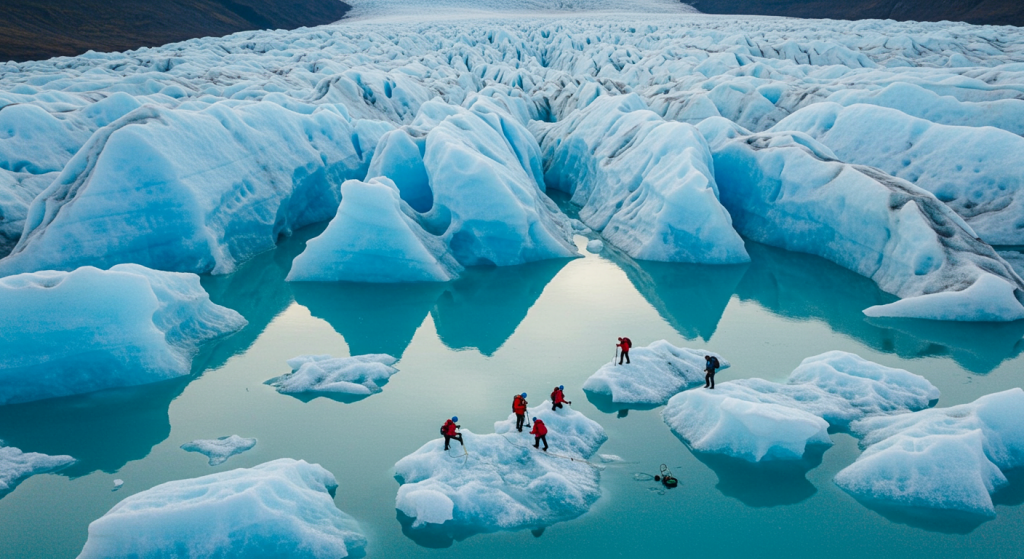By Alejandro Angulo
On March 22, as every year, World Water Day is celebrated, and this year’s theme, according to the UN, is “Conservation of Glaciers.” (In 2023, glaciers lost more than 600 gigatons of water: the largest mass loss recorded in the last 50 years. (World Meteorological Organization, WMO). Nearly 70% of the Earth’s freshwater is found in the form of snow or ice.
Today, we face a significant challenge as glaciers are melting faster than ever. As the planet’s temperature rises, our icy heritage diminishes, and the water cycle becomes more unpredictable. Therefore, conserving glaciers is an absolute priority, as saving them is a survival strategy for the planet and its inhabitants.
Currently, there is less water available on the planet due to several causes, including:
Climate change, which affects the supply of freshwater.
Pollution of water resources by activities such as mining, oil spills, and plastics.
Overexploitation of aquifers.
Rising sea levels, which salinize groundwater.
All of this brings certain consequences, such as:
More than 40% of the world’s population lacks access to sufficient drinking water.
Lack of access to clean water can cause poverty, inequality, and social injustice.
Nearly 1,000 children die every day from water-related diseases or diarrhea.
Many may wonder: How much drinking water exists on Earth? Well, freshwater is distributed as 70% frozen water (hence the importance of glaciers) located in glaciers and 30% in soil moisture or aquifers. Of the rest, 1% is found in watersheds, and only 0.025% is potable. Official data confirm that only 0.007% of the Earth’s water is drinkable, and this amount decreases year after year due to pollution.
According to UN data, 4.2 billion people currently lack access to safely managed clean water and sanitation services. Additionally, 673 million people still resort to unsanitary practices, such as open defecation. On the other hand, around 2 billion people are forced to use a drinking water source contaminated with feces.
The above leads us to consider that water is a scarce and limited resource. Moreover, as the global population grows and resource-intensive economic development continues, the water resources and infrastructure of many countries cannot meet the accelerated demand.
According to National Geographic (2023), “By 2050, approximately 6 billion people will suffer from water scarcity due to increased demand from population growth and rising pollution levels.”

Although water scarcity is a relative concept, according to UN-Water, as the amount physically accessible varies with changes in supply and demand for this resource, there is no doubt that today there is less availability than in the past, mainly due to population growth (demand) and pollution (supply).
So, what is the significance of World Water Day? It is not about increasing or conserving the available volume of this water resource but rather about the scarcity of this vital liquid.
It is said that tragedy can be experienced in many ways, which is entirely true, but in the end, all of them culminate in tragedy.
Therefore, the “tragedy of water” is considered to include “natural disasters” and water scarcity that affect communities.
Among the so-called natural disasters are floods, which consist of overflows of water that occur when water escapes from river or stream channels. These can be slow or sudden (see the recent case in Argentina). On the opposite end, we find droughts, which are phenomena that cause a decrease in water availability.
In this sense, half of the human and economic damages caused by disasters in the last fifty years are related to water and climate. Water-related disasters alone have caused nearly 1.3 million deaths and account for 50% of all disasters (World Meteorological Organization).
And as if that were not enough, there is a record of the ten main disasters during that period (1970–2019), and those that have caused the most fatalities are droughts, with 650,000 deaths; followed by storms, with 577,232; floods, with 58,700; and extreme temperatures, with 55,736 (according to the Atlas of Mortality and Economic Losses from Weather, Climate, and Hydrological Extremes, 1970–2019).
(The recent case in Argentina—March 2025—resulted in 15 deaths in the city of Bahía Blanca due to heavy rains that caused severe flooding.)
Regarding the question of how much water we have left, it is said that the total water on the Earth’s surface and underground, including ice, has decreased by one centimeter annually over the last twenty years. In Mexico, according to an essay by E. Vega (a professor at the Faculty of Economics at UNAM, University Coordinator for Sustainability, CoUS-SDI, UNAM) from 2025 (with information from SINA-CONAGUA, 2024), the per capita availability for 2025 is 3,482 m³/inhabitant, and for 2030, it will be 3,358 m³/inhabitant, meaning less (-124 m³/inhab.) than in 2025.
So, what does World Water Day lead us to? In general terms, the following can be said: to reflect on the use we make of this natural resource, to be responsible, and to collaborate to accelerate change and reverse the water crisis and its mismanagement.
The above implies greater water efficiency; reuse of wastewater; ensuring water security (which is different from the human right to water), as this security involves infrastructure, water regulation schemes, and availability of water resources (including surface water—rivers, lakes—and groundwater), which depends on climatic, geographic conditions, and resource management; water quality (Pollution of water sources by agricultural, industrial, and domestic activities compromises water security.); management and governance (Public policies, laws, and institutional mechanisms are fundamental for equitable distribution and efficient water management); climate change (It affects precipitation patterns, generates more intense droughts or floods, and alters water cycles); water demand (Population growth, industrial development, and agricultural needs can exert pressure on resources).











